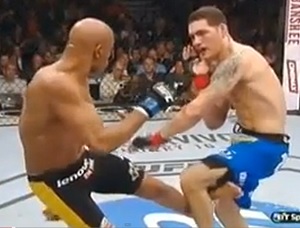UFC's Anderson Silva horrifying shin break in Weidman fight most likely due to chronic vitamin D deficiency via dark skin
 Sunday, December 29, 2013 Sunday, December 29, 2013by Mike Adams, the Health Ranger Editor of NaturalNews.com (See all articles...) Tags: Anderson Silva, leg break, vitamin D deficiency |

(NaturalNews) The UFC (Ultimate Fighting Championship) has grown to become today's most popular sport among America's youth. The sport features amazing athletes battling it out in an octagon, where competitors must combine high-level grappling skills, striking skills, fitness and a strong ground game to achieve victory. Anderson Silva (aka "the Spider") has been one of the most dominant fighters of all time, but his leg shattered in last night's fight as he struck Chris Weidman's knee with his shin. No one seems to understand why this happened, but as a nutrition scientist, I am confident of the underlying cause: Chronic vitamin D deficiency leading to fragile bones.
I am a fan of Silva and his personal philosophies, courage and dedication, so this is not a criticism of Silva. This is an explanation that all UFC athletes need to hear:
Anderson Silva is a Brazilian fighter with a tall, lean frame. Like many UFC fighters, he has dark skin pigmentation, but almost no one in the UFC realizes that dark skin pigmentation interferes with vitamin D creation in response to UV rays from sunlight. Dark skin is, essentially, a built-in "sunscreen" biological mechanism that blocks UV radiation, and that's precisely why dark-skinned people originate from geographical areas closest to the equator (because sunlight is far more intense there).
As a result of this, nearly all dark-skinned people are chronically vitamin D deficient, especially if they spend a lot of time indoors (in gyms, working in offices, etc.). Taking vitamin D supplements can reverse this situation, but many people don't realize they're deficient and fail to take sufficient quantities supplements. Many vitamin D supplements also provide far too little vitamin D to support bone density.
Chronic vitamin D deficiency causes bones to become fragile. What happens is that a lack of vitamin D greatly reduces the body's absorption and uptake of dietary calcium, strontium and other trace elements which build bone material. This is why nearly everyone with low vitamin D also has low bone density.
I have seen this very frequently among dark-skinned athletes who train and compete in mostly indoor settings. They tend to break their bones far more frequently than fair-skinned athletes who unknowingly are getting more UV radiation and therefore more vitamin D creation when they are exposed to sunlight. (For the record, your skin actually generates vitamin D in response to sunlight exposure. It's one of the few vitamins your body actually generates.)
But weak bones can also give UFC fighters a power-to-weight advantage
There's a strange upside to vitamin D deficiency in UFC fighting, however: fragile bones are also light bones, meaning the skeletal system is much lighter than it would be if the person had higher bone density.A person with chronic vitamin D deficiency and fragile bones might be described as having "bird bones." All birds have bones which are, by design, extremely lightweight and also fragile. This aids birds in achieving and sustaining flight with maximum caloric efficiency. At the same time, however, birds are very easy to crush because their bones have very little stress resistance (compared to the bones of land animals).
So a UFC fighter who has very weak bones also has lightweight bones, and this means they can pack on more muscle in proportion to their skeletal system while still meeting the required weight limit for the fight. I strongly suspect that Anderson Silva has been fighting this way for years: heavy on the muscle but light on the bones. It allowed him a higher power-to-weight ration which, combined with his unusually long legs, gave him enormous tactical advantages in the ring. He could out-reach most opponents and also out-strike them. His extraordinary coordination and athleticism further compounded the effectiveness of all this, and that's a big part of why he went undefeated for so long.
But this power-to-weight advantage is also a weakness. Fragile bones are, essentially, a "chink in the armor." One kick shattered Silva's lower leg and literally separated the bones of his lower leg from the bones extending from his knee. If you look closely in the feature photo of this story, you can see that Silva's lower shin bones are no longer attached to his upper shin bones. Only the skin is keeping it attached. The bones have completely separated.
This demonstrates the striking disadvantage of fighting with low bone mass density caused by chronic vitamin D deficiency. One wrong kick and your career can be finished. Anderson Silva will probably never fight professionally again (which is sad to see because he's such an outstanding athlete).
In summary: What every UFC fighter needs to know about vitamin D
Dark skin pigmentation = low vitamin D creation = low bone density = light skeletal system but fragile weakness of the bones.Lighter skin or high vitamin D supplementation = high bone density = heavy skeletal system with high resistance to fracturing.
Most UFC fighters are fighting with chronic vitamin D deficiency, and this is especially true among those with dark skin whose biology naturally blocks UV light. It's easy to get your bone density checked, by the way, at a doctor's office who deals with osteoporosis. There's a simple device that uses ultrasound to determine the bone density of your feet and ankles. This tells you whether your bones have a healthy density.
Watch my video below for a more detailed explanation about sunlight, vitamin D, skin cancer, dark skin pigmentation and more:
Anderson Silva at FETCH.news
Get independent news alerts on natural cures, food lab tests, cannabis medicine, science, robotics, drones, privacy and more.
 About the author:Mike Adams (aka the "Health Ranger") is a best selling author (#1 best selling science book on Amazon.com) and a globally recognized scientific researcher in clean foods. He serves as the founding editor of NaturalNews.com and the lab science director of an internationally accredited (ISO 17025) analytical laboratory known as CWC Labs. There, he was awarded a Certificate of Excellence for achieving extremely high accuracy in the analysis of toxic elements in unknown water samples using ICP-MS instrumentation. Adams is also highly proficient in running liquid chromatography, ion chromatography and mass spectrometry time-of-flight analytical instrumentation.
About the author:Mike Adams (aka the "Health Ranger") is a best selling author (#1 best selling science book on Amazon.com) and a globally recognized scientific researcher in clean foods. He serves as the founding editor of NaturalNews.com and the lab science director of an internationally accredited (ISO 17025) analytical laboratory known as CWC Labs. There, he was awarded a Certificate of Excellence for achieving extremely high accuracy in the analysis of toxic elements in unknown water samples using ICP-MS instrumentation. Adams is also highly proficient in running liquid chromatography, ion chromatography and mass spectrometry time-of-flight analytical instrumentation.
Adams is a person of color whose ancestors include Africans and Native American Indians. He's also of Native American heritage, which he credits as inspiring his "Health Ranger" passion for protecting life and nature against the destruction caused by chemicals, heavy metals and other forms of pollution.
Adams is the founder and publisher of the open source science journal Natural Science Journal, the author of numerous peer-reviewed science papers published by the journal, and the author of the world's first book that published ICP-MS heavy metals analysis results for foods, dietary supplements, pet food, spices and fast food. The book is entitled Food Forensics and is published by BenBella Books.
In his laboratory research, Adams has made numerous food safety breakthroughs such as revealing rice protein products imported from Asia to be contaminated with toxic heavy metals like lead, cadmium and tungsten. Adams was the first food science researcher to document high levels of tungsten in superfoods. He also discovered over 11 ppm lead in imported mangosteen powder, and led an industry-wide voluntary agreement to limit heavy metals in rice protein products.
In addition to his lab work, Adams is also the (non-paid) executive director of the non-profit Consumer Wellness Center (CWC), an organization that redirects 100% of its donations receipts to grant programs that teach children and women how to grow their own food or vastly improve their nutrition. Through the non-profit CWC, Adams also launched Nutrition Rescue, a program that donates essential vitamins to people in need. Click here to see some of the CWC success stories.
With a background in science and software technology, Adams is the original founder of the email newsletter technology company known as Arial Software. Using his technical experience combined with his love for natural health, Adams developed and deployed the content management system currently driving NaturalNews.com. He also engineered the high-level statistical algorithms that power SCIENCE.naturalnews.com, a massive research resource featuring over 10 million scientific studies.
Adams is well known for his incredibly popular consumer activism video blowing the lid on fake blueberries used throughout the food supply. He has also exposed "strange fibers" found in Chicken McNuggets, fake academic credentials of so-called health "gurus," dangerous "detox" products imported as battery acid and sold for oral consumption, fake acai berry scams, the California raw milk raids, the vaccine research fraud revealed by industry whistleblowers and many other topics.
Adams has also helped defend the rights of home gardeners and protect the medical freedom rights of parents. Adams is widely recognized to have made a remarkable global impact on issues like GMOs, vaccines, nutrition therapies, human consciousness.
In addition to his activism, Adams is an accomplished musician who has released over a dozen popular songs covering a variety of activism topics.
Click here to read a more detailed bio on Mike Adams, the Health Ranger, at HealthRanger.com.
Take Action: Support Natural News by linking to this article from your website
Permalink to this article:
Embed article link: (copy HTML code below):
Reprinting this article:
Non-commercial use OK, cite NaturalNews.com with clickable link.
Follow Natural News on Facebook, Twitter, Google Plus, and Pinterest
- Warp Speed 2.0: Trump Administration ACCELERATES Gates-funded, self-amplifying bird flu vaccines
- DMSO and Natural Dyes: A suppressed cancer treatment resurfaces in independent research
- Aerosolized bioweapons? Strange “diploid biomasses” falling out of the sky in Florida captured under the microscope
- Transhuman vectors of disease: Young adults continue to produce spike proteins ONE YEAR after receiving COVID vaccine
- Study finds bananas more effective than salt reduction for lowering blood pressure
- STAGING BEFORE RELEASE: WHO Runs 2-Day Pandemic Simulation 'Exercise Polaris'
- Chemical cocktails in processed foods linked to diabetes, validating natural health warnings
- Prominent doctors call for new holistic therapies to address CANCER SPIKE: Tree barks provide anti-cancer treatment options
- 8 U.S. states may EXPAND vaccine exemptions in 2025, and parents have many reasons to STOP THE SHOTS
- Fermented foods like sauerkraut may outshine modern medicine in gut health, research finds
- Ancient mummies rewrite human history with “ghost” lineage discovery
- Widespread social and economic unrest: Steve Quayle issues urgent financial warning of imminent asset collapse in new interview with Mike Adams
- Analysis: The coming economic collapse, a mass uprising and Trump's three secret weapons to halt the growing revolt
- U.S. lawmakers investigate Meta over alleged China collaboration
- Mike Adams releases country western hit single: Goin’ Back in Time is Comin’ Home
- Surge in KIDNEY FAILURES linked to common medications
- Fauci is back in the limelight, and he’s busy promoting a future COVID or FLU pandemic
- Kiss Your Genetic Privacy Good-Bye! 23andMe Gets Green Light to Sell Your Intimate Genetic Details to Anyone They Want
- Israeli lobbyists boast of controlling US national security policy in leaked AIPAC audio
- Aerosolized bioweapons? Strange “diploid biomasses” falling out of the sky in Florida captured under the microscope
- Analysis: The coming economic collapse, a mass uprising and Trump's three secret weapons to halt the growing revolt
- Fauci is back in the limelight, and he’s busy promoting a future COVID or FLU pandemic
- Widespread social and economic unrest: Steve Quayle issues urgent financial warning of imminent asset collapse in new interview with Mike Adams
- Kiss Your Genetic Privacy Good-Bye! 23andMe Gets Green Light to Sell Your Intimate Genetic Details to Anyone They Want
- Mike Adams releases country western hit single: Goin’ Back in Time is Comin’ Home
- U.S. lawmakers investigate Meta over alleged China collaboration
- Tulsi Gabbard leads charge against the Biden regime’s global censorship of the 'Disinformation Dozen'
- Pfizer's RSV vaccine linked to preterm births as drug giant CONCEALED RISKS from pregnant women in unethical clinical trials
- Dane Wigington exposes climate engineering as ‘All-Out Weather and Biological Warfare’
- Shedding light on the dark side of MMR vaccines: How vaccinated individuals SPREAD MEASLES & put the vulnerable at risk
- TAKE IT DOWN Act advances in Congress amid free speech concerns
- CLOT SHOT PLANDEMIC UNFOLDING: Fibrous, rubbery clots caused by covid injections have prion-like seeding activity
- Chemtrails unveiled: How the CIA and Big Business are manipulating the weather for profit
- Curcumin’s ancient healing power supercharges muscle recovery, and its effects are compounded with anti-inflammatory foods and supplements
- Criminal referral requests filed against Fauci and top COVID officials in seven states
- Defunding DEADLY mRNA jabs: Government funding for mRNA technology being scrutinized and sidelined until proven "safe and effective" for real
- Newly released JFK files reveal Pentagon's role in creating Lyme disease and covid in the same lab
- Analysis: The coming economic collapse, a mass uprising and Trump's three secret weapons to halt the growing revolt
- Mike Adams releases country western hit single: Goin’ Back in Time is Comin’ Home
- Aerosolized bioweapons? Strange “diploid biomasses” falling out of the sky in Florida captured under the microscope
- Kiss Your Genetic Privacy Good-Bye! 23andMe Gets Green Light to Sell Your Intimate Genetic Details to Anyone They Want
- European Court of Justice: Healthcare professionals who promoted or administered COVID-19 vaccines are CRIMINALLY LIABLE for any harm caused
- Federal employees whine over DOGE's new directive requiring them to do a 5-point summary of weekly accomplishments
- Widespread social and economic unrest: Steve Quayle issues urgent financial warning of imminent asset collapse in new interview with Mike Adams
- U.S. approves new Russian ambassador as diplomatic thaw continues
- Government waste exposed: Hegseth supports Musk’s demand for accountability from federal workers
- Now you can HEAR chemistry: Health Ranger translates molecules into music in stunning video demonstration that will blow your mind (and your ears)
- Fauci is back in the limelight, and he’s busy promoting a future COVID or FLU pandemic
- CLOT SHOT PLANDEMIC UNFOLDING: Fibrous, rubbery clots caused by covid injections have prion-like seeding activity
- I Want My Bailout Money – new song released by Mike Adams
- I Want My Bailout Money – new song and music video released by Mike Adams
- Tulsi Gabbard leads charge against the Biden regime’s global censorship of the 'Disinformation Dozen'
- Trump administration poised to overhaul crypto regulations with new SEC leadership
- The Health Ranger releases “Vaccine Zombie” song and music video, using AI-animated zombies for the music video
- Red Cross issues warning to stop blood plasma donations from vaccinated people
- Scientists confirm: GENIUS brain function can be spontaneously unleashed in humans without any apparent cause
- EPA advisor admits the agency is funneling billions to climate groups ahead of Trump’s return to White House
- HYSSOP: What research reveals about the health benefits of this ancient holy herb
- Two containers with completed ballots fall out of truck in Florida
- Newly released JFK files reveal Pentagon's role in creating Lyme disease and covid in the same lab
- Global leaders unite to clamp down on “misinformation” with UN-backed Cascais Declaration
- Mike Adams releases country western hit single: Goin’ Back in Time is Comin’ Home
- BREAKING: 2025 NDAA authorizes mandatory military draft of WOMEN across America… as Pentagon pursues global NUCLEAR war with both Russia and China at the same time
- Michael Yon warns of a ZIONIST TAKEOVER in Trump’s second administration
- The Health Ranger releases “Vaccine Zombie” song and music video, using AI-animated zombies for the music video
- Ozempic and Wegovy weight loss drugs are injectable LIZARD VENOM PEPTIDES that may unleash a devastating wave of organ failure… side effects align with symptoms of SNAKE BITES
- BOMBSHELL: DNA testing kits are a SCAM to develop ethnic-specific bioweapons
- Israeli soldiers accused of even more torture and abuse in the West Bank
- I Want My Bailout Money – new song released by Mike Adams
- These 13 countries just signed an agreement to engineer a global FAMINE by destroying food supply
- NASA admits that climate change occurs because of changes in Earth’s solar orbit, and NOT because of SUVs and fossil fuels
- RFK Jr. clears key hurdle: Sen. Susan Collins backs controversial HHS nominee, signaling a new era for health policy
Science News & Studies
Medicine News and Information
Food News & Studies
Health News & Studies
Herbs News & Information
Pollution News & Studies
Cancer News & Studies
Climate News & Studies
Survival News & Information
Gear News & Information
News covering technology, stocks, hackers, and more



"Big Tech and mainstream media are constantly trying to silence the independent voices that dare to bring you the truth about toxic food ingredients, dangerous medications and the failed, fraudulent science of the profit-driven medical establishment.
Email is one of the best ways to make sure you stay informed, without the censorship of the tech giants (Google, Apple, Facebook, Twitter, YouTube, etc.). Stay informed and you'll even likely learn information that may help save your own life."
–The Health Ranger, Mike Adams












































